Puppy Potty Training: Housebreaking Time
Whether you are bringing home a new puppy or a full-grown rescue, you must be prepared for the fact that the dog will not know where you expect him or her to go to the bathroom unless you potty train your puppy. You should expect many accidents before your dog is reliably potty trained, meaning that you will probably restrict your dog to certain areas of the house until you are sure he or she has figured out what you want him or her to do.
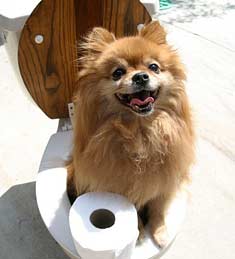
Is the bathroom inside or outside?
The most fundamental decision you must make is whether you want your dog to have a place indoors where he or she can take care of business or if you want the bathroom to be strictly outdoors. Many factors go into this decision, including your work schedule or other activities that keep you away from your dog, the layout of your home and yard, and whether or not you will have a doggy door to allow your dog to come and go as he or she pleases.
The average puppy will need to make water every two to three hours, and most of us have work schedules that prevent us from walking a dog this often. For this reason, many people decide to paper train the dog or use an indoor dog potty to keep the dog from having to cross his or her legs for too long.
Adult dogs may be able to make it through an 8-hour work day, but smaller breeds with correspondingly smaller bladders may have a tough time with this. Geriatric dogs will begin to have trouble holding their waste for long periods and may cause you to go back to an indoor system if you have to be away from home for long periods of time, even if your dog had waited for you in the past.
Outdoor Potty Training
If your dog’s bathroom will be strictly outside, training will consist of two components: teaching your dog where the bathroom is, and teaching him not to relieve him/her-self elsewhere. The minute you bring your new dog of whatever age to your home, walk him or her around the area where you want him to use the restroom. Let the dog sniff the area and try to stay out there until the dog does his or her duty. If the area is scented from another dog, so much the better. Praise the dog as soon as the deed is done. Showing appreciation for his or her hard work and maybe giving a small treat will go a long way toward cementing the lesson in the dog’s brain.
Your dog wants nothing so much as to please you, so praise is an invaluable training tool. Consistency is also key. About every two hours, lead your dog back to the designated area. You may encourage the dog by saying, “let’s go potty” in an excited voice. The dog will come to associate the word “potty” with the desired behavior. The dog should also be taken to the potty spot about 20 minutes to a half hour after each meal. Don’t forget to continue the training overnight. Set your alarm if necessary, as your dog’s bladder doesn’t understand the difference between night and day.
After your dog eliminates outside, don’t clean it up right away unless you are worming the dog. Leaving some of the mess to “scent” the area will encourage the dog to go again next time.
To keep your dog from soiling inside the house, crate training is invaluable. A dog will typically not use the bathroom close to where he has to sleep. If you buy a crate that is large enough to allow your dog to turn around, but not so large that he or she can urinate at one end and sleep at the other, s/he will quickly learn that s/he doesn’t want to soil his or her living quarters in the crate. Be fair! Don’t expect the dog to gain bladder control just because he or she is stuck in a crate. You will still need to lead the dog to the designated bathroom spot every few hours day and night.
When your dog does have the inevitable accident indoors, you should show the dog the mess and tell him or her “no” very firmly, then lead the dog outside to the designated bathroom spot. If your yard is fenced, leave the dog outside until you get the mess cleaned up. There is no need to rub the dog’s nose in the mess or to spank the dog. Both of these methods are abusive and counter-productive. The only thing you should use a rolled-up newspaper for is to slap it against your hand if you need to get the dog’s attention.
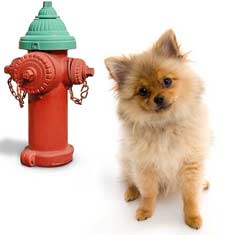
Indoor Training
Training your dog to use the bathroom indoors is slightly easier, if only because your dog can get to his or her bathroom without your having to open the door. Again, training has two key components: teaching the dog where to go, and teaching the dog where NOT to go.
The simplest bathroom to set up inside your home is several layers of newspaper. When the dog goes to the bathroom, you simply remove the top layer, leaving behind the scent to attract your dog the next time the urge strikes.
Many companies make dog potties that involve some sort of fake grass and a pan to catch urine as it leaks through. The pan is emptied and the grass can be cleaned in a shower, bathtub or with the garden hose. The different manufacturers boast different designs which are meant to provide better protection for your home and / or attract the dog to the system more reliably.
The training process is analogous to that for outdoor potties. Lead your dog to the potty, keep him or her there until the deed is done, then praise the dog as if you’ve conquered Westminster! Repeat this process until your dog gets the idea and begins to go to the correct spot of his or her own accord.
Preserving your carpets during potty training
The best place to keep an untrained dog when he or she isn’t in a crate is a small, non-carpeted area. Baby gates can help restrict your dog to rooms that don’t have regular doors such as kitchens or laundry rooms. This arrangement allows your dog to have room to play (preferably with you), while still allowing your carpets to survive the experience. Place the dog’s food and water at one end of the room, toys in the middle, and newspapers or indoor potty at the other end. This allows the dog to have a designated eating spot, a play spot, and a potty spot. You may also place a bed near the toys or food and water dishes, if desired.
A dog bed or blanket should never be used in a crate, as it allows the dog to urinate, soak up the urine in the towel or bed, then scoot the mess to one end of the crate. He or she can then sleep in dry comfort, even though a mess has been made. You want the dog to associate bathroom accidents with having to be wet and uncomfortable to encourage proper bathroom use. This isn’t mean; it’s simply a way to provide natural consequences to help your dog learn what you want. Clean the bottom of the kennel each time you take the dog out, so he or she gets a fresh start each time the crate is used.
Good luck! With patience and consistency, even the most stubborn dog will eventually learn to go to the bathroom where you think it is appropriate rather than wherever the urge strikes.
Doggies Den: Latest Articles
 Homemade Thanksgiving Treats for Your Dog
Homemade Thanksgiving Treats for Your Dog
NUTRITION We all want to include our dogs in our holiday celebrations, but hopefully, you're aware that sharing table scraps with your dog isn't always the best idea.
 Keeping Your Dog Safe during the Summer Months
Keeping Your Dog Safe during the Summer Months
HEALTH Summer is coming on fast, so it’s time to plan how you will keep your dog safe and healthy through the lazy, carefree, warm days.
 Vaccination Time Again-Keeping Your Puppy Healthy
Vaccination Time Again-Keeping Your Puppy Healthy
DOG HEALTH So you have your new puppy picked out. There are quite a few shots, treatments and examinations that will keep the newest member of your family healthy.
 Canine Thanksgiving Feast
Canine Thanksgiving Feast
NUTRITION With the wide variety of food at Thanksgiving dinner, chances are you'll want to give your dog something special, too. If you're contemplating what to feed your dog for the holiday, here is a guide to a great Canine Thanksgiving Feast.
 Dog Walking Tips Every Owner Should Know
Dog Walking Tips Every Owner Should Know
DOG FUN Walking your dog is not only crucial to keeping him healthy and happy, it strengthens the bond between your canine friend and his caregiver. There are a lot of obstacles out there. Don’t forget these simple tips to keep your walk fun and safe in the outside world.
 The Benefits of Physiotherapy for your Dog
The Benefits of Physiotherapy for your Dog
HEALTH The same techniques that physiotherapists use to treat a variety of injuries and conditions in humans have been adapted to suit animals with great success. Family pets, show dogs, and working dogs can all benefit greatly from physiotherapy. Dogs whose activities involve a lot of agility are especially susceptible to the types of problems that physiotherapy can address.
 The Decision- Adding a Dog to Your Family
The Decision- Adding a Dog to Your Family
FIRST TIME OWNERSBringing a dog into your family is a decision where many people don’t realize it’s magnitude until after they have the dog. There are a number of things that you need to research before you decide to purchase a dog, and it starts right in your own home.
 Bringing Your Dog Into Your New Baby's Life
Bringing Your Dog Into Your New Baby's Life
HEALTH Many believe that a dog and a new baby cannot happily coexist, so therefore the dog has to go. This is not necessarily the case.  A new baby does not mean you have to abandon your dog.

Doggies Den:
Most Popular Articles

Dog Pregnancy Symptoms
HEALTHIf you suspect your dog might be pregnant, check out part one in this series on pregnant dogs, where we cover pregnant dog symptoms.
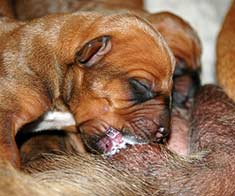
Dog Birth
HEALTHIn the third article of our dog pregnancy series, we look at the wonderful, but messy, process of bringing newborn puppies into the world.

Indoor Dog Potties
DOG PRODUCTSIt's been a long day at work. You were so busy, you didn't even take time to eat a sandwich, let alone run home to let your dog out. You're on your way home, knowing the poor dog is crossing his or her legs by now, when your car breaks down, delaying you even further. Can't somebody make this easier?
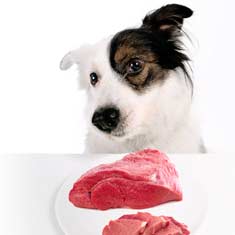
Your Dog’s Digestive System
PHYSIOLOGYEver wonder why your dog eats so fast? Or why he eats gross things? Or why he gets sick to his stomach? Or why his waste stinks so bad? Some of these things are normal, some are not.

Canine Respiratory System
BREATHINGThe basic function of your dog's respiratory system is to bring oxygen in to and remove carbon dioxide from the body. Knowing the symptoms of respiratory diseases can help you help your stay healthy.
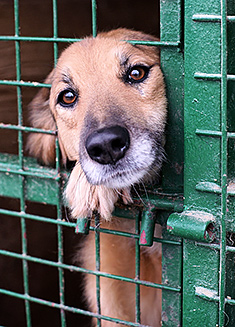
Shelter Dog Adoption Tips for Success
ADOPTION Are you intimidated by the prospect of "rescuing" a dog from a shelter? One reason that you may be wary of adopting a dog from a shelter is not knowing how to choose. Adopting a dog from a shelter can be a rewarding process, if you're prepared to do a reasonable amount of research.

Canine Urinary Tract Infections
SYMPTOMS AND TREATMENTDoes your dog seem to be having trouble relieving his or her bladder? Learn how to recognize the signs of urinary tract infections and how to treat them before they spread.

What to do for Dog Diarrhea
SYMPTOMS AND REMEDIESIf you have dogs in your house for any length of time, you have likely experienced at least one bout of dog diarrhea. Beyond the pain in the tuckus involved in cleaning up the mess, you should know what causes diarrhea, and when it's important to see the vet.
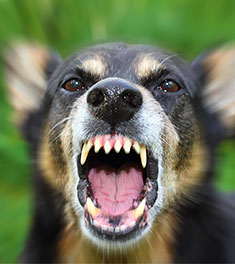
What to do for a Dog Bite
DOG BEHAVIOR Getting bitten by a dog can be scary, and you may be tempted to run around in circles for a while, trying to figure out what to do. Here's our guide to help you manage the situation.

Top Ten Tips for Living with a Senior Dog
DOG HEALTH Bringing home a new puppy is so exciting, but it doesn’t take all that long for your exuberant puppy to grow into a senior dog who may have special needs. Here are the doggies.com top ten tips for taking care of your companion who has been with you through so much.
